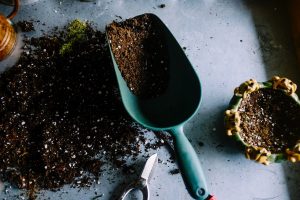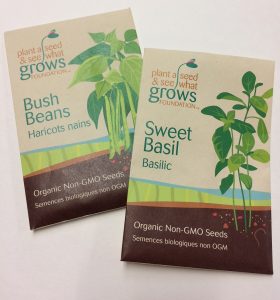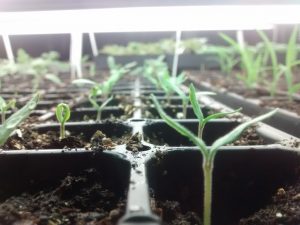Jessica Hill, one of the Foundation’s garden expert offers her expertise on how to prepare your garden for spring. Get your tips here. Spring is in the air!
How to Prepare Your Garden for Spring
It’s that exciting time of year again, the ground is beginning to warm and the trees are beginning to bud. Before we know it, we’ll be pulling carrots from the ground and slicing freshly picked tomatoes from the backyard. But even before we have plants in the garden, there’s still a lot we can do. Appropriate preparation work can assure a nutritious harvest and save new gardeners disappointment. Whether you are new to gardening or already have a schoolyard, backyard or community garden, here are 8 tips to help you prepare for a successful growing season.
For the New Gardener – Build a Raised Bed
If you don’t yet have a garden you may want to consider building a raised bed. Raised beds are ideal for small scale gardeners and are helpful to use because you can fill the garden box with healthy soil and know that your plants will be nourished. Make sure to build the garden box with untreated lumber and place it in a location that gets a lot of sun. Another option is to buy garden boxes.

Photo courtesy of Life Space Gardens
Clean Your Garden Tools

Photo by Neslihan Gunaydin on Unsplash.com
Clean your garden tools so that everything is ready to go as soon as it’s time to start working with the earth. Remove the rust, sharpen the edges of shovels, trowels and hoes, and wipe everything down. It’s especially important to start the season with clean tools so you don’t accidentally spread fungus or insect eggs into the garden. Regular maintenance of garden tools will keep them efficient and help them last longer.
Set-Up a Compost System
If you don’t already have one, consider establishing your own compost system for this coming season. Making your own compost is a terrific way to cut costs on fertilizers. You can add kitchen scraps, garden material and yard trimmings to your compost. Choose a compost system that is suitable to the amount of plant material you will add to it. Smaller gardens may consider vermicomposting or a tumbler-style bin, while larger gardens may consider a three-bin composting system.
Source Your Seeds
Source quality seeds from a local seed grower. Locally grown seeds are more adapted to your region’s climate and environment. Choose seeds that will grow well in the amount of sunlight your garden receives. Crops that can be planted in the early growing season include beans, broccoli, parsley, arugula, kale, lettuce and tomato.

The Foundation has a limited selection of organic and non-GMO seeds for sale.
Remove Weeds
Pull out all the weeds from your garden, along with fallen branches and large plant debris. Note that if the soil is still wet from the winter wait until it is dry enough before attempting heavy weeding or tilling. Working the soil when it’s too wet can compact and damage the soil structure. Waiting until it is dry enough helps keep the soil texture aerated, which plants will grow best in. You can tell if your soil is ready by taking a handful and using your hands to press the soil together so it forms a ball. The soil is ready to be worked, if the ball crumbles easily. If it retains its shape or only breaks into large chunks that do not crumble, it needs more time to dry out.
Add Compost to the Soil
When the soil is ready, add compost. Compost is the greatest gift you can give to your soil. It replaces the nutrients that were lost from the previous growing season, improves the soil structure and creates a friendly habitat for beneficial insects and microorganisms. It is important to replenish the soil with compost at the beginning of every growing season, at the very least. If you don’t yet have your own compost, you will want to find a quality source that is suitable for vegetable gardens. You can look at your local garden center, a compost provider, municipality or a farmer. Layer 1-2 inches of compost on top of the soil and then turn it under to a depth of about 6 inches before planting.
Start Transplants
You can give your seeds a head start by growing transplants indoors. You will need to get seed starting trays and a decent quality potting soil for seed starting. Plant seeds in the starting trays according to the directions on their packet. Place the seeds in a warm room with lots of light. Keep the soil moist as the seedlings grow. About a week before planting the seedlings outdoors, start to place them outside for increasing increments throughout the day and bring them in at night. This process is called “hardening off” and will help the seedlings adjust to outdoor conditions.

Plan for Maintenance
A vegetable garden requires regular work of watering, weeding, harvesting, and more! It is helpful to plan for the maintenance of your garden. If it is a backyard garden, think about who can water your plants when you are out of town. If it is a schoolyard garden, consider gathering volunteers for summer break, as these will be the garden’s busiest months. Want to get the kids involved in the garden? The Foundation offers free educational materials for Canadian teachers & students from Kindergarten-Grade 3 in English and in French.

Jessica has a BASc Sustainable Agriculture from Kwantlen Polytechnic University. Read more about her here.
If you would like to know more about the work of the Foundation, please sign-up to become a Friend of the Foundation. For inquiries about how to support the Foundation’s work in school gardens and post-secondary education bursaries, please contact us.







